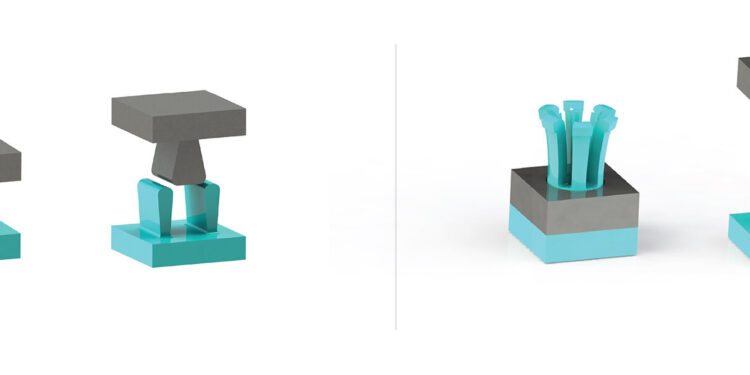An individual cell of the two proposed versions of ILM in their different engagement states. Credit: Dr Ibrahim Karaman
In a collaborative effort between Texas A&M University and Sandia National Laboratories, researchers have significantly improved a new assembly technology, interlocking metasurfaces (ILM), designed to increase the strength and stability of a structure compared to traditional techniques such as bolts and adhesives, using shapes. memory alloys (SMA).
ILMs offer the potential to transform mechanical seal design in aerospace, robotic and biomedical device manufacturing.
“ILMs are poised to redefine assembly technologies across a range of applications, much like Velcro did several decades ago,” said Dr. Ibrahim Karaman, professor and head of the Department of materials science and engineering at Texas A&M.
“Together with Sandia National Laboratories, the original developers of ILMs, we designed and manufactured ILMs using shape memory alloys. Our research demonstrates that these ILMs can be selectively disengaged and reengaged on demand while maintaining consistent joint strength and structural integrity. “
Results can be found in Materials and design.
Similar to Legos or Velcro, ILMs allow two bodies to be joined by transmitting force and limiting movement. Until now, this assembly method has been passive, requiring force for engagement.
Using 3D printing, teams designed and manufactured active ILMs by integrating shape memory alloys (SMAs), notably nickel-titanium, which can return to their original shape after deformation by temperature change.
Credit: Materials and design (2024). DOI: 10.1016/j.matdes.2024.113137
Controlling assembly technology through temperature changes opens new possibilities for intelligent, adaptive structures without loss of strength or stability and with increased options for flexibility and functionality.
“Active ILMs have the potential to revolutionize mechanical joint design in industries requiring precise, repeatable assembly and disassembly,” said Abdelrahman Elsayed, graduate research assistant in Texas A&M’s Department of Materials Science and Engineering. .
Practical applications include the design of reconfigurable aerospace engineering components where parts must be assembled and disassembled multiple times. Active ILMs could also provide flexible and adaptable joints to improve robotics functionality. In the field of biomedical devices, the ability to adjust implants and prosthetics to body movements and temperatures could provide a better option for patients.
The current findings used the shape memory effect of SMAs to recover the shape of ILMs by adding heat. The researchers hope to build on these results by using the superelasticity effect of SMAs to create ILMs that can withstand large deformations and recover instantly under very high stress levels.
“We anticipate that integrating SMAs into ILMs will unlock many future applications, although several challenges remain,” Karaman said.
“Achieving superelasticity in complex 3D printed ILMs will enable localized control of structural stiffness and facilitate reattachment with high locking forces. Additionally, we hope that this technology will address long-standing challenges associated with assembly techniques in extreme environments. We are very excited about the transformative potential. of ILM technology.”
Other contributors include Dr. Alaa Elwany, associate professor in the Wm Michael Barnes ’64 Department of Industrial and Systems Engineering, and doctoral student Taresh Guleria in the Department of Industrial Systems and Engineering.
More information:
Abdelrahman Elsayed et al, Actively interlocking metasurfaces enabled by shape memory alloys, Materials and design (2024). DOI: 10.1016/j.matdes.2024.113137
Provided by Texas A&M University College of Engineering
Quote: Move over, bolts: Discover the future of stronger structural connections with interlocking metasurfaces (October 7, 2024) retrieved October 7, 2024 from
This document is subject to copyright. Except for fair use for private study or research purposes, no part may be reproduced without written permission. The content is provided for informational purposes only.



